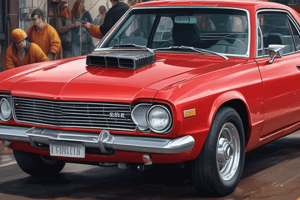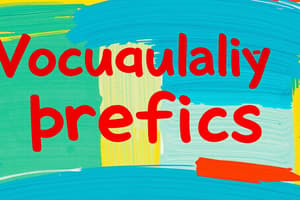Podcast
Questions and Answers
What is the primary advantage of using the 'Dry-on-Dry' painting technique?
What is the primary advantage of using the 'Dry-on-Dry' painting technique?
- Improving the color saturation
- Reducing the risk of runs and sags (correct)
- Achieving a high-gloss finish
- Increasing the transfer efficiency
What is the purpose of a clear coat in the Base Coat-Clear Coat (BC-CC) painting technique?
What is the purpose of a clear coat in the Base Coat-Clear Coat (BC-CC) painting technique?
- To protect the paint (correct)
- To achieve a high-gloss finish
- To increase the transfer efficiency
- To reduce the risk of runs and sags
What is the primary difference between Urethane Clear and Acrylic Clear coats?
What is the primary difference between Urethane Clear and Acrylic Clear coats?
- Environmental friendliness
- Transfer efficiency
- Hardening process (correct)
- High-gloss finish
What is the term for the brightness or intensity of a color?
What is the term for the brightness or intensity of a color?
What is the purpose of cleaning a surface before painting?
What is the purpose of cleaning a surface before painting?
What is the term for matching a color by using specialized equipment?
What is the term for matching a color by using specialized equipment?
Flashcards are hidden until you start studying
Study Notes
Painting Techniques
- Wet-on-Wet: Applying multiple coats of paint without allowing previous coats to dry, achieving a high-gloss finish.
- Dry-on-Dry: Applying multiple coats of paint, allowing each coat to dry before applying the next, reducing the risk of runs and sags.
- Base Coat-Clear Coat (BC-CC): Applying a colored base coat and a clear coat to achieve a high-gloss finish and protect the paint.
Clear Coat Application
- Application Methods:
- Spray Gun: Using a spray gun to apply clear coat, allowing for a smooth, even finish.
- HVLP (High Volume, Low Pressure): A spray gun technology that reduces overspray and increases transfer efficiency.
- Clear Coat Types:
- Urethane Clear: A two-part clear coat that hardens when mixed with a catalyst.
- Acrylic Clear: A water-borne clear coat that dries quickly and is environmentally friendly.
Color Matching
- Color Theory:
- Hue: The actual color (e.g., red, blue).
- Saturation: The brightness or intensity of the color.
- Value: The lightness or darkness of the color.
- Color Matching Techniques:
- Visual Match: Matching the color by eye, using a color chart or fan deck.
- Instrumental Match: Using specialized equipment (e.g., spectrophotometer) to measure and match the color.
Surface Preparation
- Cleaning:
- Solvents: Using solvents (e.g., mineral spirits, acetone) to remove contaminants and grease.
- Abrasion: Using abrasives (e.g., sandpaper, Scotch-Brite) to remove rust, corrosion, and old coatings.
- Surface Finishing:
- Sanding: Using progressively finer grits to smooth the surface.
- Polishing: Using compounds and polishes to remove scratches and imperfections.
Metal Repair
- Damage Assessment:
- Inspection: Identifying the extent of the damage and determining the necessary repairs.
- Estimating: Estimating the time and materials needed for the repair.
- Repair Techniques:
- Welding: Using heat to fuse metal together, repairing holes and tears.
- Bondo: Using a polyester-based filler to repair dents and holes.
- Panel Beating: Using specialized tools to shape and form metal panels.
Studying That Suits You
Use AI to generate personalized quizzes and flashcards to suit your learning preferences.




